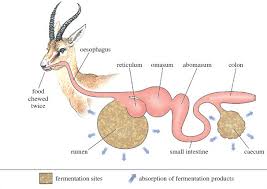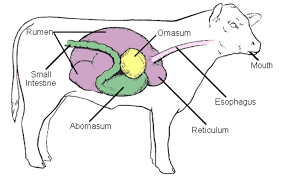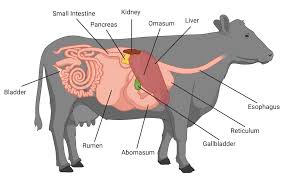In this article, the digestion process in ruminant animals is explored. Ruminants possess a digestive system that is significantly different from that of monogastric animals. In fact, the nature of the ruminant digestive process forms the basis for what will be studied in subsequent articles, where feed materials and the feeding of sheep, goats, and cattle are discussed.
Understanding Digestion in Ruminant Animals
Digestion is the process through which complex food substances are broken into simpler components that animals can absorb and utilize. The gastrointestinal tract functions as a tube from the mouth to the anus. Along this tract, some parts are widened into chambers and others receive digestive secretions. The wall of this tube is vital, as all nutrients are absorbed through it.
Read Also: Rose Chafer: Description, Damages Caused, Control and Preventive Measures
The Digestion Process in Ruminant Animals

The rumen consists of pillars, and rhythmic contractions of these pillars cause the rumen to contract and expand, leading to the mixing of its contents. The rumen content includes a more liquid part at the bottom and a dense, floating “raft” of solid, mainly fibrous materials.
This dense, floating fibrous material is what the ruminant regurgitates and chews further. The act of regurgitation reduces the particle size of the fibrous materials, increasing the surface area for microbial attack in the rumen and reticulum.
1. Carbohydrate Digestion in The Rumen of Ruminants
The first micro-organisms to attack food in the rumen are fungi; these secrete enzymes that break down surrounding fibers, thereby reducing the physical strength of food particles and allowing the entry of bacteria and protozoa.
The rumen is an anaerobic (oxygen-free) environment. Under this condition, protozoa and bacteria secrete enzymes capable of breaking down the β-linkage in forages and other fibrous feed materials to produce pyruvic acid (pyruvate), which is further broken down (oxidised) to produce Volatile Fatty Acids (VFA).
The major fatty acids produced in the rumen are acetic acid, propionic acid, and butyric acid. Others include valeric and iso-butyric acids, obtained from microbial metabolism of protein.
The VFAs produced from the incomplete digestion of carbohydrates are absorbed through the rumen wall. The energy produced during anaerobic fermentation is lower compared to aerobic (oxygen-dependent) fermentation, where the end products are carbon dioxide and water.
2. Protein Digestion in The Rumen of Ruminants
Some of the protein consumed by ruminants may escape microbial fermentation in the rumen and pass unchanged into the abomasum. These proteins, which are digested through enzymic action in the abomasum, are important in ruminant nutrition and are referred to by names such as “Bypass Protein,” “Rumen Escape Protein,” and “Rumen Undegradable Protein (RUP).”
The fraction of dietary proteins that is degraded in the rumen is referred to as Rumen Degraded Protein (RDP). The end products of RDP digestion include simple amino acids, ammonia, and some urea. Digestion moves from the reticulorumen through the reticulo-omasal orifice to the omasum. The major role of the omasum is the absorption of the volume of water that accompanies the digesta.
3. Digestion Process in The Hind-gut of Ruminants
Once the digesta enters the abomasum, it undergoes a series of changes through enzymatic actions similar to what occurs in the simple stomach of monogastric animals.
Read Also: Bedbugs: Description, Damages Caused, Control and Preventive Measures
Development and Digestion in Young Ruminants

Ruminants are not born with a fully functional rumen. At birth, the rumen and reticulum together account for about 30% of the total volume of the four stomach chambers. By the age of two months, this increases to about 70%, and in mature cows, the rumen and reticulum together occupy 85% of the stomach volume. The abomasum, on the other hand, decreases from 70% at birth to 7% of the volume in adults.
In young ruminants feeding solely on the dam’s milk, fore-gut digestion does not occur. Instead, milk passes straight from the oesophagus to the abomasum through the oesophageal groove. This groove forms as a reflex action initiated by suckling.
This mechanism is important in calf nutrition because it allows milk to bypass microbial fermentation, which would otherwise reduce its quality. As the animal matures and begins to consume grasses and other solid feed materials, this ability to close the groove is lost, and the rumen gradually develops to its adult state.
Advantages of Ruminant Digestion Process in Agriculture
- The microbial population in the rumen enhances nutrient metabolism by allowing effective utilisation of fibrous materials, especially cellulose, through the action of protozoa and bacteria that break down the β-linkages.
- Micro-organisms convert certain feed components into essential nutrients; for instance, ruminants use Non-Protein Nitrogen (NPN) to synthesise cellular proteins, reducing reliance on high-quality proteins and allowing the use of compounds like urea as a protein source.
- The microbial population in the rumen produces all B-complex vitamins, eliminating the need for these to be added to the feed. Exceptions include vitamins A, D, and E.
Disadvantages Of Ruminant Digestion Process in Agriculture
During microbial fermentation, 4 to 10 percent of the energy consumed is lost as methane and hydrogen gases, which cannot be utilised by the animal and are considered wasted.
Most dietary proteins are broken down into ammonia and then converted to microbial protein, which in some cases is of lower quality than the original dietary protein, leading to nutrient wastage.
Simple sugars such as glucose and starches are completely fermented into VFAs. Although VFAs can be used by animal tissues, they provide energy less efficiently than the original carbohydrates.
Do you have any questions, suggestions, or contributions? If so, please feel free to use the comment box below to share your thoughts. We also encourage you to kindly share this information with others who might benefit from it. Since we can’t reach everyone at once, we truly appreciate your help in spreading the word. Thank you so much for your support and for sharing!

